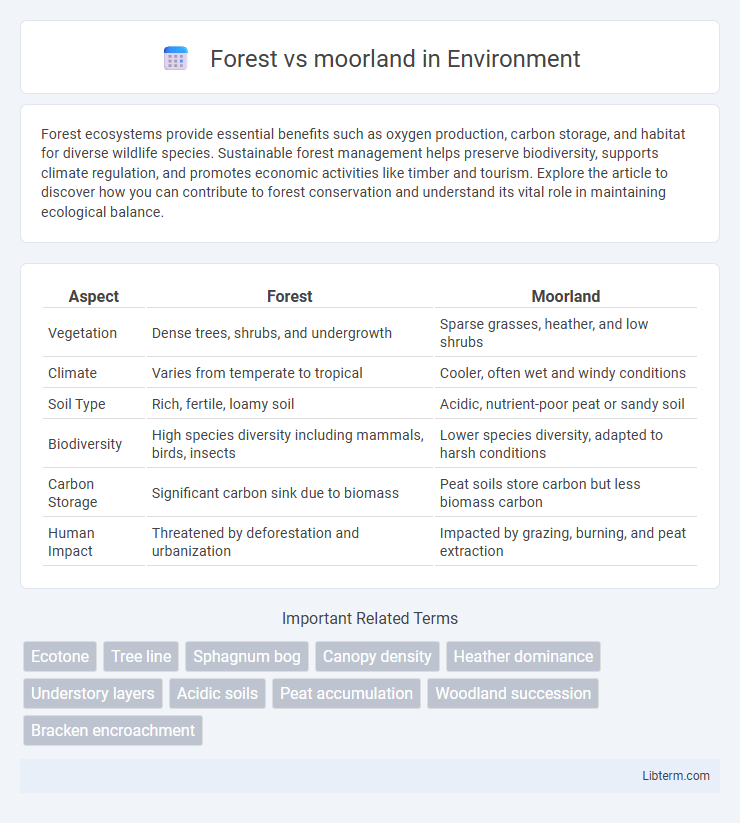Forest ecosystems provide essential benefits such as oxygen production, carbon storage, and habitat for diverse wildlife species. Sustainable forest management helps preserve biodiversity, supports climate regulation, and promotes economic activities like timber and tourism. Explore the article to discover how you can contribute to forest conservation and understand its vital role in maintaining ecological balance.
Table of Comparison
| Aspect | Forest | Moorland |
|---|---|---|
| Vegetation | Dense trees, shrubs, and undergrowth | Sparse grasses, heather, and low shrubs |
| Climate | Varies from temperate to tropical | Cooler, often wet and windy conditions |
| Soil Type | Rich, fertile, loamy soil | Acidic, nutrient-poor peat or sandy soil |
| Biodiversity | High species diversity including mammals, birds, insects | Lower species diversity, adapted to harsh conditions |
| Carbon Storage | Significant carbon sink due to biomass | Peat soils store carbon but less biomass carbon |
| Human Impact | Threatened by deforestation and urbanization | Impacted by grazing, burning, and peat extraction |
Introduction to Forests and Moorlands
Forests are densely wooded areas dominated by trees, providing critical habitats for diverse flora and fauna, and playing a significant role in carbon sequestration. Moorlands are open, often elevated landscapes characterized by heather, grasses, and low shrubs, thriving in acidic, nutrient-poor soils with distinct ecosystems adapted to wetter, cooler climates. Both forests and moorlands contribute to biodiversity and environmental stability but differ markedly in vegetation structure, soil types, and ecological functions.
Key Differences Between Forests and Moorlands
Forests are densely wooded areas characterized by a high density of trees, whereas moorlands consist of open, treeless landscapes dominated by shrubs and heather. Forest ecosystems support diverse wildlife with complex canopy layers, while moorlands provide habitats for specialized bird species adapted to acidic, nutrient-poor soils. Soil composition and moisture levels differ significantly, with forests thriving in richer, well-drained soils and moorlands existing on acidic, wet, and often peat-rich ground.
Climate and Environmental Conditions
Forests thrive in regions with moderate to high rainfall and stable temperatures, supporting dense tree growth that regulates local climate by sequestering carbon and maintaining humidity levels. Moorlands exist in cooler, wetter climates with acidic, nutrient-poor soils, where low-growing vegetation such as heather dominates, providing unique habitats for specialized wildlife and acting as important carbon sinks through peat accumulation. Both ecosystems play crucial roles in biodiversity conservation and climate regulation but differ significantly in hydrology, soil composition, and vegetation structure.
Vegetation Types and Plant Diversity
Forests typically feature dense tree coverage with a multilayered structure including canopy, understory, and ground vegetation, supporting a high diversity of tree species such as oaks, pines, and maples. Moorlands are characterized by open landscapes dominated by low-growing vegetation like heather, grasses, and mosses, with plant species adapted to acidic, nutrient-poor soils and often including ericaceous shrubs and sedges. Plant diversity in forests is generally higher due to varied habitats and microclimates, whereas moorlands possess specialized flora adapted to harsh conditions and periodic disturbance regimes.
Wildlife and Biodiversity Comparison
Forests support a diverse range of wildlife including mammals, birds, insects, and fungi, with complex food webs and rich biodiversity due to dense vegetation and abundant resources. Moorlands, characterized by open, acidic soils and low-growing vegetation such as heather and grasses, host specialized species like red grouse, skylarks, and various invertebrates adapted to harsh conditions. While forests often exhibit higher species richness, moorlands provide critical habitats for rare and endemic species, contributing uniquely to regional biodiversity conservation.
Soil Composition and Nutrient Availability
Forest soils typically exhibit higher organic matter content and richer nutrient availability due to leaf litter and humus accumulation, fostering fertile conditions for diverse plant growth. Moorland soils are often acidic, podzolized, and low in nutrients, with a high proportion of peat or organic-rich topsoil that retains moisture but limits nutrient cycling. The contrasting soil compositions in forests and moorlands significantly influence vegetation types and ecosystem productivity.
Ecological Importance and Ecosystem Services
Forests support high biodiversity by providing habitat for numerous species and contribute to carbon sequestration, climate regulation, and soil preservation. Moorlands, characterized by open, low-growing vegetation on acidic, nutrient-poor soils, play a vital role in water regulation, carbon storage in peat soils, and sustaining unique flora and fauna adapted to these environments. Both ecosystems offer critical services such as biodiversity conservation, climate mitigation, and hydrological balance essential for ecological health.
Human Impact and Land Use
Human activities have transformed forests and moorlands through deforestation, agriculture, and urban expansion, leading to habitat loss and altered ecosystems. Forests often face logging and land clearing for farming, reducing biodiversity and carbon storage capacity. Moorlands are impacted by grazing, peat extraction, and burning practices, which can degrade soil quality and disrupt native species.
Conservation Challenges and Strategies
Forests face conservation challenges such as deforestation, habitat fragmentation, and invasive species, requiring strategies like reforestation, habitat corridors, and strict logging regulations to restore biodiversity. Moorlands struggle with issues like peat degradation, overgrazing, and climate change impacts, demanding controlled burning, sustainable grazing practices, and peatland restoration projects to maintain carbon storage and ecosystem health. Effective conservation integrates adaptive management, community engagement, and monitoring to address the distinct ecological functions and pressures of both forests and moorlands.
Future Outlook for Forests and Moorlands
Forests are expected to expand in area due to increasing global reforestation efforts and carbon sequestration initiatives, with advanced remote sensing technologies enhancing monitoring and management. Moorlands face uncertain futures as climate change alters precipitation patterns and temperatures, impacting their delicate peatland ecosystems and biodiversity crucial for carbon storage. Sustainable land management and conservation policies will be essential to balance the ecological functions and economic uses of both habitats.
Forest Infographic

 libterm.com
libterm.com